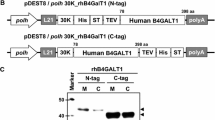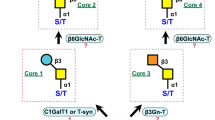Abstract
The peptide-N 4-(N-acetyl-β-d-glucosaminyl) asparagine amidase F (PNGase F) catalyzes the cleavage of N-linked oligosaccharides between the innermost GlcNAc and asparagine residues of high mannose, hybrid and complex oligosaccharides from glycoproteins. The PNGase F has broad substrate specificity and thus is extensively used for the structural and functional studies of the glycoproteins. In this study, we tried to produce active recombinant PNGase F as secreted and intracellular-expressed forms using baculovirus expression vector system (BEVS) through silkworm larvae or cultured cells. PNGase F itself contains potential N-linked glycosylation sites and we found that it was N-glycosylated when PNGase F secreted from silkworm cells. Intriguingly, the secreted recombinant PNGase F has the lower catalytic activity and self-digests its N-linked glycans and therefore this secreted form of this enzyme produced from BEVS is not appropriate for carbohydrate chain analysis. Instead, we successfully mass-produced (2.1 mg/20 silkworm larvae) and purified active recombinant PNGase F as an intracellular protein without N-glycosylations. Besides, we confirmed by directed mutagenesis that several amino acid residues are crucial for the function of PNGase F. Our results provide an alternative method for the mass production of active enzymes involved in the study of glycoproteins.







Similar content being viewed by others
References
Imperiali, B., & O’Connor, S. E. (1999). Effect of N-linked glycosylation on glycopeptides and glycoprotein structure. Current Opinion in Chemical Biology, 3, 643–649.
Apweiler, R., Hermjakob, H., & Sharon, N. (1999). On the frequency of protein glycosylation, as deduced from analysis of the SWISS-PROT database. Biochimica et Biophysica Acta, 1473, 4–8.
Plummer, T. H, Jr, Elder, J. H., Alexander, S., Phelan, A. W., & Tarentino, A. L. (1984). Demonstration of peptide: N-glycosidase F activity in endo-beta-N-acetylglucosaminidase F preparations. The Journal of Biological Chemistry, 259, 10700–10704.
Elder, J. H., & Alexander, S. (1982). Endo-beta-N-acetylglucosaminidase F: Endoglycosidase from Flavobacterium meningosepticum that cleaves both high-mannose and complex glycoproteins. Proceedings of the National Academy of Sciences of the United States of America, 79, 4540–4544.
Chu, F. K. (1986). Requirements of cleavage of high mannose oligosaccharides in glycoproteins by peptide N-glycosidase F. The Journal of Biological Chemistry, 261, 172–177.
Tretter, V., Altmann, F., & März, L. (1991). Peptide-N 4-(N-acetyl-beta-glucosaminyl)asparagine amidase F cannot release glycans with fucose attached alpha 1-3 to the asparagine-linked N-acetylglucosamine residue. European Journal of Biochemistry, 199, 647–652.
Mussar, K. J., Murray, G. J., Martin, B. M., & Viswanatha, T. (1989). Peptide: N-glycosidase F: studies on the glycoprotein aminoglycan amidase from Flavobacterium meningosepticum. Journal of Biochemical and Biophysical Methods, 20, 53–68.
Norris, G. E., Stillman, T. J., Anderson, B. F., & Baker, E. N. (1994). The three-dimensional structure of PNGase F, a glycosylasparaginase from Flavobacterium meningosepticum. Structure, 2, 1049–1059.
Barsomian, G. D., Johnson, T. L., Borowski, M., Denman, J., Ollington, J. F., Hirani, S., et al. (1990). Cloning and expression of peptide-N 4-(N-acetyl-beta-D-glucosaminyl) asparagine amidase F in Escherichia coli. The Journal of Biological Chemistry, 265, 6967–6972.
Loo, T., Patchett, M. L., Norris, G. E., & Lott, J. S. (2002). Using secretion to solve a solubility problem: high-yield expression in Escherichia coli and purification of the bacterial glycoamidase PNGase F. Protein Expression and Purification, 24, 90–98.
Hua, L., Gao, X., Yang, X., Wan, D., He, C., Cao, J., et al. (2014). Highly efficient production of peptides: N-Glycosidase F for N-glycomics analysis. Protein Expression and Purification, 97, 17–22.
O’Reilly, D. R., Miller, L., & Luckow, V. A. (1992). Baculovirus expression vectors: A laboratory manual (pp. 216–234). New York: Oxford University Press.
Kato, T., Kajikawa, M., Maenaka, K., & Park, E. Y. (2010). Silkworm expression system as a platform technology in life science. Applied Microbiology and Biotechnology, 85, 459–470.
Mitsudome, T., Xu, J., Nagata, Y., Masuda, A., Iiyama, K., Morokuma, D., et al. (2014). Expression, purification, and characterization of endo-β-N-acetylglucosaminidase H using baculovirus-mediated silkworm protein expression system. Applied Biochemistry and Biotechnology, 172, 3978–3988.
Ono, C., Nakatsukasa, T., Nishijima, Y., Asano, S., Sahara, K., & Bando, H. (2007). Construction of the BmNPV T3 bacmid system and its application to the functional analysis of BmNPV he65. Journal of Insect Biotechnology and Sericology, 76, 161–167.
Soejima, Y., Lee, J., Nagata, Y., Mon, H., Iiyama, K., Kitano, H., et al. (2013). Comparison of signal peptides for efficient protein secretion in the baculovirus-silkworm system. Central European Journal of Biology, 8, 1–7.
Kuhn, P., Tarentino, A. L., Plummer, T. H, Jr, & Van Roey, P. (1994). Crystal structure of peptide-N 4-(N-acetyl-beta-D-glucosaminyl) asparagine amidase F at 2.2-A resolution. Biochemistry, 33, 11699–11706.
Kuhn, P., Guan, C., Cui, T., Tarentino, A. L., Plummer, T. H., & Van Roey, P. (1995). Active site and oligosaccharide recognition residues of peptide-N 4-(N-acetyl-beta-D-glucosaminyl)asparagine amidase F. The Journal of Biological Chemistry, 270, 29493–29497.
Lemp, D., Haselbeck, A., & Klebl, F. (1990). Molecular cloning and heterologous expression of N-glycosidase F from Flavobacterium meningosepticum. The Journal of Biological Chemistry, 265, 15606–15610.
Tarentino, A. L., Quinones, G., Trumble, A., Changchien, L. M., Duceman, B., Maley, F., et al. (1990). Molecular cloning and amino acid sequence of peptide-N 4-(N-acetyl-beta-D-glucosaminyl)asparagine amidase from Flavobacterium meningosepticum. The Journal Biological Chemistry, 265, 6961–6966.
Lee, J., Kawakami, N., Mon, H., Mitsunobu, H., Iiyama, K., Ninaki, S., et al. (2012). Establishment of a Bombyx mori nucleopolyhedrovirus (BmNPV) hyper-sensitive cell line from the silkworm e21 strain. Biotechnology Letters, 34, 1773–1779.
Motohashi, T., Shimojima, T., Fukagawa, T., Maenaka, K., & Park, E. Y. (2005). Efficient large-scale protein production of larvae and pupae of silkworm by Bombyx mori nuclear polyhedrosis virus bacmid system. Biochemical and Biophysical Research Communications, 326, 564–569.
Mon, H., Lee, J., Fukushima, M., Nagata, Y., Fujii, M., Xu, J., et al. (2013). Production and characterization of the celery mismatch endonuclease CEL II using baculovirus/silkworm expression system. Applied Microbiology and Biotechnology, 97, 6813–6822.
Kawakami, N., Lee, J., Mon, H., Kubo, Y., Banno, Y., Kawaguchi, Y., et al. (2008). Efficient protein expression in Bombyx mori larvae of the strain d17 highly sensitive to B. mori nucleopolyhedrovirus. Molecular Biotechnology, 40, 180–185.
Green, E. D., Adelt, G., Baenziger, J. U., Wilson, S., & Van Halbeek, H. (1988). The asparagine-linked oligosaccharides on bovine fetuin. Structural analysis of N-glycanase-released oligosaccharides by 500-megahertz 1H NMR spectroscopy. The Journal of Biological Chemistry, 263, 18253–18268.
Corradi Da Silva, M. L., Stubbs, H. J., Tamura, T., & Rice, K. G. (1995). 1H NMR characterization of a hen ovalbumin tyrosinamide N-linked oligosaccharide library. Archives of Biochemistry and Biophysics, 318, 465–475.
Harvey, D. J., Wing, D. R., Küster, B., & Wilson, I. B. (2000). Composition of N-linked carbohydrates from ovalbumin and co-purified glycoproteins. Journal of American Society for Mass Spectrometry, 11, 564–571.
Fu, D., Chen, L., & O’Neill, R. A. (1994). A detailed structural characterization of ribonuclease B oligosaccharides by 1H NMR spectroscopy and mass spectrometry. Carbohydrate Research, 261, 173–186.
Acknowledgments
The NIAS-Bm-oyanagi2 cell line for propagation of recombinant BmNPVs was kindly provided by Dr. Imanihi (National Institute of Agrobiological Sciences, Japan). We also thank Dr. Chisa Aoki (Kyushu University Graduate School) for providing the Bme21 cell line for the expression of recombinant protein. The MALDI-TOF MS was kindly supported by Center for Advanced Instrumental and Educational Supports (Faculty of Agriculture, Kyushu University).
Conflict of interest
None.
Author information
Authors and Affiliations
Corresponding author
Electronic supplementary material
Below is the link to the electronic supplementary material.
Supplemental Fig. 1
Diagram of substrate specificities of PNGase F. The reaction results in release of the oligosaccharide and the aspartic acid-containing polypeptide. PNGase F is not able to cleave N-linked glycans from glycoproteins when the innermost GlcNAc residue is linked to an α(1-3) fucose residue. Black arrow represents the cleavage site of PNGase F. Gray circles: mannose, Black squares: GlcNAc, Black triangle: fucose, X: any sugar. Supplementary material 1 (JPEG 420 kb)
Supplemental Fig. 2
Comparison of the enzymatic activity of 30K-PNGase F before and after the self-digestion. 30K-PNGase F (self-digested) was generated by incubating 30K-PNGase F under the reaction condition at 37 °C for 1 h. 200 ng of 30K-PNGase F (with N-glycan) (lane 2, 3), 30K-PNGase F (self-digested) (lane 4, 5) and NoSP-PNGase F (lane 6, 7) which were incubated with denatured 15 μg fetuin (lane 3, 5, 7) at 37 °C for 1 h and that before the incubation (lane 2, 4, 6) were analyzed by CBB-stained 10 % SDS-PAGE. The arrows indicate the bands of rPNGase F. Mock (lane 1): fetuin without enzyme treatment. M: molecular mass markers. Supplementary material 2 (JPEG 525 kb)
Supplemental Fig. 3
Purification of rPNGase F by nickel affinity chromatography. The NoSP-PNGase F proteins purified from (a) the Bme21 cells, and (b) the silkworm fat bodies by nickel affinity chromatography. M molecular mass markers, IP input, FT flow-through, WS wash fraction, lanes 1–9 elution fractions by 500 mM imidazole. All samples were analyzed by Coomassie-stained 10 % SDS-PAGE, and the arrows indicate the bands of rPNGase F. Supplementary material 3 (JPEG 652 kb)
Supplemental Fig. 4
Structure of N-linked oligosaccharides of RNase B. The gray circles and black squares represent mannose and GlcNAc, respectively. Black arrow represents the cleavage site of PNGase F. Supplementary material 4 (JPEG 524 kb)
Rights and permissions
About this article
Cite this article
Masuda, A., Xu, J., Mitsudome, T. et al. Mass Production of an Active Peptide-N-Glycosidase F Using Silkworm-Baculovirus Expression System. Mol Biotechnol 57, 735–745 (2015). https://doi.org/10.1007/s12033-015-9866-1
Published:
Issue Date:
DOI: https://doi.org/10.1007/s12033-015-9866-1




